
Trees of the Caribbean Basin
Encyclopedia

Europe
Europe is, by convention, one of the world's seven continents. Comprising the westernmost peninsula of Eurasia, Europe is generally 'divided' from Asia to its east by the watershed divides of the Ural and Caucasus Mountains, the Ural River, the Caspian and Black Seas, and the waterways connecting...
an settlement, the Caribbean
Caribbean
The Caribbean is a crescent-shaped group of islands more than 2,000 miles long separating the Gulf of Mexico and the Caribbean Sea, to the west and south, from the Atlantic Ocean, to the east and north...
was dominated by forest
Forest
A forest, also referred to as a wood or the woods, is an area with a high density of trees. As with cities, depending where you are in the world, what is considered a forest may vary significantly in size and have various classification according to how and what of the forest is composed...
ed ecosystem
Ecosystem
An ecosystem is a biological environment consisting of all the organisms living in a particular area, as well as all the nonliving , physical components of the environment with which the organisms interact, such as air, soil, water and sunlight....
s. The insular Caribbean has been considered a biodiversity hotspot
Biodiversity hotspot
A biodiversity hotspot is a biogeographic region with a significant reservoir of biodiversity that is under threat from humans.The concept of biodiversity hotspots was originated by Norman Myers in two articles in “The Environmentalist” , revised after thorough analysis by Myers and others in...
. Although species diversity
Species diversity
Species diversity is an index that incorporates the number of species in an area and also their relative abundance. It is a more comprehensive value than species richness....
is lower than on mainland systems, endemism is high.
Species diversity is highest and endemism is lowest in Trinidad
Trinidad
Trinidad is the larger and more populous of the two major islands and numerous landforms which make up the island nation of Trinidad and Tobago. It is the southernmost island in the Caribbean and lies just off the northeastern coast of Venezuela. With an area of it is also the fifth largest in...
, which has a predominantly continental flora. Endemism is highest in Cuba
Cuba
The Republic of Cuba is an island nation in the Caribbean. The nation of Cuba consists of the main island of Cuba, the Isla de la Juventud, and several archipelagos. Havana is the largest city in Cuba and the country's capital. Santiago de Cuba is the second largest city...
and Hispaniola
Hispaniola
Hispaniola is a major island in the Caribbean, containing the two sovereign states of the Dominican Republic and Haiti. The island is located between the islands of Cuba to the west and Puerto Rico to the east, within the hurricane belt...
, the largest members of the Greater Antilles
Greater Antilles
The Greater Antilles are one of three island groups in the Caribbean. Comprising Cuba, Jamaica, Hispaniola , and Puerto Rico, the Greater Antilles constitute almost 90% of the land mass of the entire West Indies.-Greater Antilles in context :The islands of the Caribbean Sea, collectively known as...
.
AnnonaceaeAnnonaceaeAnnonaceae, also called the custard apple familyis a family of flowering plants consisting of trees, shrubs or rarely lianas.With about 2300 to 2500 species and more than 130 genera,...
- Annona trinitensis
- DuguetiaDuguetiaDuguetia is a genus of trees and shrubs in the plant family Annonaceae with approximately 90 species in central and South America, and four species in west Africa.- Species :*Duguetia aberrans Maas *Duguetia adiscandra Jans.-Jac....
- Duguetia lucida
- Duguetia tobagensisDuguetia tobagensisDuguetia tobagensis is a small tree in the plant family Annonaceae which is endemic to Trinidad and Tobago. The species is only known from Tobago.-Description:...
- RolliniaRolliniaRollinia is a genus in the family Annonaceae. While it is widely recognised as a distinct genus a recent monograph advocates its inclusion in Annona, which also contains custard apples and soursops....
- Rollinia mucosa
- Rollinia exsucca
AraliaceaeAraliaceaeAraliaceae is a family of flowering plants, also known as the Aralia family or Ivy family. The family includes 254 species of trees, shrubs, lianas and perennial herbaceous plants into 2 subfamilies...
- AraliaAraliaAralia , or Spikenard, is a genus of the plant family Araliaceae, consisting of 68 accepted species of deciduous or evergreen trees, shrubs, and rhizomatous herbaceous perennials. The genus is native to Asia and the Americas, with most species occurring in mountain woodlands...
- Aralia excelsa
- Aralia rex
- DendropanaxDendropanaxDendropanax is a genus of flowering plants in the family Araliaceae, consisting of 92 species of evergreen trees and shrubs. They are native to Central and South America, eastern Asia and the Malay Peninsula....
- Dendropanax arboreus
- Dendropanax blakeanus
- Dendropanax cordifolius
- Dendropanax cuneifolius
- Dendropanax elongatus
- Dendropanax filipes
- Dendropanax grandiflorus
- Dendropanax grandis
- Dendropanax laurifoliusDendropanax laurifoliusDendropanax laurifolius is a tree in the family Araliaceae. It is endemic to Puerto Rico, and is found in moist regions of forests at middle or high elevations....
- Dendropanax nervosus
- Dendropanax nutans
- Dendropanax oblanceatus
- Dendropanax pendulus
- Dendropanax portlandianus
- Dendropanax selleanus
- Dendropanax swartzii
- OreopanaxOreopanaxOreopanax is a genus of shrubs and trees in the family Araliaceae, comprising between 80 and 150 species depending on source. They are native to the Americas, with a range extending from Mexico and the Antilles to Argentina and Brazil, with most species occurring above 500 m.a.s.l. Sinopanax was...
- Oreopanax capitatus
- Oreopanax dussii
- Oreopanax ramosissimus
- ScheffleraScheffleraSchefflera is a genus of flowering plants in the family Araliaceae. The plants are trees, shrubs or lianas, growing tall, with woody stems and palmately compound leaves. The circumscription of the genus has varied greatly...
- Schefflera attenuata
- Schefflera glabrata
- Schefflera gleasoniiSchefflera gleasoniiSchefflera gleasonii is a species of plant in the Araliaceae family. It is endemic to Puerto Rico.-Source:* World Conservation Monitoring Centre 1998. . Downloaded on 23 August 2007....
- Schefflera morototoniSchefflera morototoniSchefflera morototoni is a timber tree native to southern Mexico, the Greater Antilles, Central America, and South America...
- Schefflera sciodaphyllum
- Schefflera stearniiSchefflera stearniiSchefflera stearnii is a species of plant in the Araliaceae family. It is endemic to Jamaica. It is threatened by habitat loss.-Source:* World Conservation Monitoring Centre 1998. . Downloaded on 23 August 2007....
- Schefflera tremula
- Schefflera troyanaSchefflera troyanaSchefflera troyana is a species of plant in the Araliaceae family. It is endemic to Jamaica. It is threatened by habitat loss.-Source:* World Conservation Monitoring Centre 1998. . Downloaded on 23 August 2007....
- Schefflera urbanianaSchefflera urbanianaSchefflera urbaniana is a species of plant in the Araliaceae family. It is endemic to Martinique.-Source:* World Conservation Monitoring Centre 1998. . Downloaded on 23 August 2007....
BignoniaceaeBignoniaceaeThe Bignoniaceae, or Trumpet Creeper Family, is a family of flowering plants comprising about 650-750 species in 116-120 genera. Members of the family are mostly trees and lianas , shrubs and more rarely herbaceous plants. As climber plants, they are twine climbers or tendril climbers, and rarely...
- Catalpa longissima
- CrescentiaCrescentiaCrescentia is a genus of six species of flowering plants in the family Bignoniaceae, native to southern North America, the Caribbean, Central America and northern South America...
- Crescentia cujeteCrescentia cujeteCrescentia cujete, commonly known as the Calabash Tree, is species of flowering plant that is native to Central and South America. It is a dicotyledonous plant with tripinnate leaves...
(Calabash) - Crescentia portoricensisCrescentia portoricensisCrescentia portoricensis is a species of plant in the Bignoniaceae family. It is a perennial evergreen shrub endemic to Puerto Rico. It is threatened by habitat loss.C...
- Crescentia cujete
- TabebuiaTabebuiaTabebuia is a neotropical genus of about 100 species in the tribe Tecomeae of the family Bignoniaceae. The species range from northern Mexico and southern Florida south to northern Argentina, including the Caribbean islands of Hispaniola and Cuba...
- Tabebuia heterophylla
- Tabebuia roseaTabebuia roseaTabebuia rosea is a neotropical tree that grows up to and can reach a diameter at breast height of up to . The name Roble de Sabana is widely used in Costa Rica meaning "savannah oak" in Spanish, probably because it often remains in heavily deforested areas, where people prize its intense...
- Tecoma stansTecoma stansTecoma stans is a species of flowering perennial shrub in the trumpet vine family, Bignoniaceae, that is native to the Americas. Common names include Yellow Trumpetbush, Yellow Bells , Yellow Elder, Ginger-thomas, and Esperanza...
BoraginaceaeBoraginaceaeBoraginaceae, the Borage or Forget-me-not family, include a variety of shrubs, trees, and herbs, totaling about 2,000 species in 146 genera found worldwide.A number of familiar plants belong to this family....
- Bourreria succulenta
- CordiaCordiaCordia is a genus of flowering plants in the borage family, Boraginaceae. It contains about 300 species of shrubs and trees, which are found worldwide mostly in warmer regions. Many of the species are commonly called manjack, while bocote may refer to several Central American species in Spanish...
- Cordia alliodora
- Cordia sulcata
- Rochefortia acanthophora
BurseraceaeBurseraceaeBurseraceae is a moderate-sized family of 17-18 genera and about 540 species of flowering plants. The actual numbers differ according to the time period in which a given source is written describing this family. The Burseraceae is also known as the Torchwood family, the frankincense and myrrh...
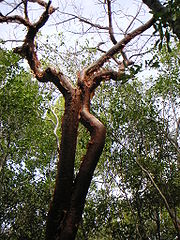
- Dacryodes excelsaDacryodes excelsaDacryodes excelsa is a tree of the Caribbean region. Its vernacular names include tabonuco, gommier, and candlewood....
(Tabonuco) - Bursera simarubaBursera simarubaBursera simaruba, commonly known as the Gumbo-limbo, is a tree species in the family Burseraceae, native to tropical regions of the Americas from the southeasternmost United States south through Mexico and the Caribbean to Brazil and Venezuela...
BuxaceaeBuxaceaeBuxaceae are a small family of four or five genera and about 90-120 species of flowering plants. They are shrubs and small trees, with a cosmopolitan distribution...
- BuxusBuxusBuxus is a genus of about 70 species in the family Buxaceae. Common names include box or boxwood ....
- Buxus aneura
- Buxus brevipes
- Buxus crassifolia
- Buxus ekmanii
- Buxus excisa
- Buxus heterophylla
- Buxus imbricata
- Buxus muelleriana
- Buxus olivacea
- Buxus pilosula
- Buxus portoricensis
- Buxus rheedioides
- Buxus vahliiBuxus vahliiBuxus vahlii is a rare species of plant in the boxwood family. It is native to Puerto Rico and St. Croix in the U.S. Virgin Islands, where it is known from no more than four populations total. It has probably never been very common, but its distribution has been reduced by deforestation and other...
Capparidaceae
- CapparisCapparisCapparis is a flowering plant genus in the family Capparaceae which is included in the Brassicaceae in the unrevised APG II system. These plants are shrubs or lianas and are collectively known as caper shrubs or caperbushes...
- Capparis baducca
- Capparis cynophallophoraCapparis cynophallophoraCapparis cyanophallophora, commonly known as the Jamaican Caper, is small tree in the caper family, Capparaceae, that is native to the neotropics.-Description:...
- Capparis flexuosa
- Capparis hastataCapparis hastataCapparis hastata is a plant species in the genus Capparis....
- Capparis indica
CelastraceaeCelastraceaeThe Celastraceae , is a family of about 90-100 genera and 1,300 species of vines, shrubs and small trees, belonging to the order Celastrales...
- Cassine xylocarpa
- Gyminda latifolia
- MaytenusMaytenusMaytenus is a genus of flowering plants in the staff vine family, Celastraceae. Members of the genus are distributed throughout Central and South America, Southeast Asia, Micronesia and Australasia, the Indian Ocean and Africa...
- Maytenus monticola
- Maytenus reflex
- Schaefferia frutescensSchaefferia frutescensSchaefferia frutescens is a species of flowering plant in the staff vine family, Celastraceae, that is native to tropical regions of the Americas, from southern Florida in the United States, south through the Caribbean to Central America and northwestern South America , and also Veracruz in Mexico...
ClusiaceaeClusiaceaeThe Clusiaceae or Guttiferae Juss. is a family of plants formerly including about 37 genera and 1610 species of trees and shrubs, often with milky sap and fruits or capsules for seeds. It is primarily tropical...
- CalophyllumCalophyllumCalophyllum is a flowering plant genus of around 180-200 species of tropical evergreen trees in the family Calophyllaceae. The generic name is derived from the Greek words καλος , meaning "beautiful", and φυλλον , meaning "leaf." Its members are native to Australasia, Madagascar, Eastern Africa,...
- Calophyllum calaba
- Calophyllum lucidum
- ClusiaClusiaClusia is the type genus of the family Clusiaceae. Comprising 140-150 species, it is native to tropical and subtropical America. Its species are shrubs, vines and small to medium-size trees up to 20 m tall, with evergreen foliage...
- Clusia aripoensis
- Clusia intertexta
- Clusia minor
- Clusia rosea
- Clusia tocuchensis
- Mammea americana
CombretaceaeCombretaceaeCombretaceae is a family of flowering plants in the order Myrtales. The family includes about 600 species of trees, shrubs, and lianas in 18 genera. The family includes the leadwood tree, Combretum imberbe. Three genera, Conocarpus, Laguncularia and Lumnitzera, grow in mangrove habitats ....
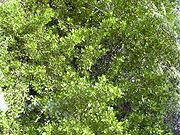
- Buchenavia tetraphylla
- Bucida buceras
- Conocarpus erectus–Buttonwood
- Laguncularia racemosaLaguncularia racemosaLaguncularia racemosa is a species of flowering plant in the leadwood tree family, Combretaceae...
- Terminalia amazonia
CupressaceaeCupressaceaeThe Cupressaceae or cypress family is a conifer family with worldwide distribution. The family includes 27 to 30 genera , which include the junipers and redwoods, with about 130-140 species in total. They are monoecious, subdioecious or dioecious trees and shrubs from 1-116 m tall...
- Juniperus barbadensisJuniperus barbadensisJuniperus barbadensis is a species of conifer in the Cupressaceae family.It is found in The Bahamas, Cuba, Haiti, Jamaica, and Saint Lucia.-References:* Conifer Specialist Group 2000. . Downloaded on 10 July 2007....
- Juniperus graciliorJuniperus graciliorJuniperus gracilior is a species of conifer in the Cupressaceae family that is endemic to the Caribbean island of Hispaniola. It is threatened by habitat loss.-Source:* Conifer Specialist Group 1998. . Downloaded on 10 July 2007....
- Juniperus saxicolaJuniperus saxicolaJuniperus saxicola is a species of conifer in the Cupressaceae family.It is found only in Cuba.-Source:* Conifer Specialist Group 1998. . Downloaded on 10 July 2007....
CyrillaceaeCyrillaceaeCyrillaceae is a small family of flowering plants in the order Ericales, native to warm temperate to tropical regions of the Americas. The family comprises two genera, each with a single species, Cyrilla racemiflora and Cliftonia monophylla....
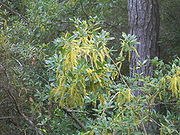
- Cyrilla racemiflora
ElaeocarpaceaeElaeocarpaceaeElaeaocarpaceae is a family of flowering plants. The family approximately contains 605 species of trees and shrubs in 12 genera. The largest genera are Elaeocarpus, with about 350 species, and Sloanea, with about 150....
- Muntingia calaburaMuntingia calaburaMuntingia calabura, the sole species in the genus Muntingia, is a flowering plant native to southern Mexico, the Caribbean, Central America, and western South America south to Peru and Bolivia...
- Sloanea berteriana
- Sloanea caribaea
ErythroxylaceaeErythroxylaceaeThe Erythroxylaceae is a family of flowering plants consisting of 4 genera and approximately 240 species. The best-known species is the coca plant , the source of the drug cocaine....
- ErythroxylumErythroxylumErythroxylum is a genus of tropical flowering plants in the family Erythroxylaceae. Many species contain the drug cocaine; Erythroxylum coca, a native of South America, is the main commercial source of cocaine and of the mild stimulant coca tea...
- Erythroxylum areolatum
- Erythroxylum brevipes
- Erythroxylum rotundifolium
- Erythroxylum urbanii
EuphorbiaceaeEuphorbiaceaeEuphorbiaceae, the Spurge family are a large family of flowering plants with 300 genera and around 7,500 species. Most are herbs, but some, especially in the tropics, are also shrubs or trees. Some are succulent and resemble cacti....
- Adelia rincinella
- Alchornea latifolia
- Bernardia dichotoma
- Fluggea acidoton
- Gymnanthes lucidaGymnanthes lucidaGymnanthes lucida, commonly known as Shiny Oysterwood, is a species of flowering plant in the spurge family, Euphorbiaceae, that is native to southern Florida in the United States, the Bahamas, the Caribbean, Mexico, and Central America. It is a tree, reaching a height of ....
- Hura crepitans
- Jatropha hernandiifolia
- Picrodendron baccatum
- Savia sessiliflora
FabaceaeFabaceaeThe Fabaceae or Leguminosae, commonly known as the legume, pea, or bean family, is a large and economically important family of flowering plants. The group is the third largest land plant family, behind only the Orchidaceae and Asteraceae, with 730 genera and over 19,400 species...
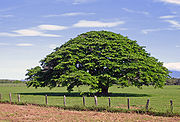
- Andira inermisAndira inermisAndira inermis is a nitrogen-fixing tree native to the area from southern Mexico through Central America to northern South America ; it has been introduced to the Caribbean, the Antilles, Florida, and Africa...
- Caesalpinia coriaria
- Enterolobium cyclocarpum
- Hymenaea courbaril
- IngaIngaInga is a genus of small tropical, tough-leaved, nitrogen-fixing trees and shrubs, subfamily Mimosoideae. Ingas leaves are pinnate, and flowers are generally white...
- Inga fagifolia
- Inga vera
- Mora excelsa
- Ormosia krugii
- Pictetia aculeata
- Piscidia carthagenensis
- Pithecellobium unguis-cati
- Pterocarpus officinalis
MalpighiaceaeMalpighiaceaeMalpighiaceae is a family of flowering plants in the order Malpighiales. It comprises approximately 75 genera and 1300 species, all of which are native to the tropics and subtropics...
- ByrsonimaByrsonimaByrsonima is one of about 75 genera in the Malpighiaceae, a family of flowering plants in the order Malpighiales. In particular in American English, they are known as locustberries...
- Byrsonima crassifolia
- Byrsonima spicata
MagnoliaceaeMagnoliaceaeThe Magnoliaceae, or Magnolia Family, is a flowering plant family in the order Magnoliales. It consists of two subfamilies:*Magnolioideae, of which Magnolia is the most well-known genus....
- MagnoliaMagnoliaMagnolia is a large genus of about 210 flowering plant species in the subfamily Magnolioideae of the family Magnoliaceae. It is named after French botanist Pierre Magnol....
- Magnolia cristalensis
- Magnolia cubensis
- Magnolia dealbataMagnolia dealbataMagnolia dealbata is a species of plant in the Magnoliaceae family. It is endemic to Mexico. It is threatened by habitat loss.-Cultivation:Magnolia dealbata is grown as an ornamental tree in gardens.-Source:* Vovides, A.P. 1998. ....
- Magnolia domingensis
- Magnolia ekmanii
- Magnolia emarginata
- Magnolia hamorii
- Magnolia minorMagnolia minorMagnolia minor is a species of plant in the Magnoliaceae family. It is endemic to Cuba. It is threatened by habitat loss.-Sources:* Areces-Mallea, A.E. 1998. . Downloaded on 22 August 2007....
- Magnolia pallescens
- Magnolia portoricensis
- Magnolia splendensMagnolia splendensMagnolia splendens, commonly known as the Laurel magnolia, Shining Magnolia or locally as the laurel sabino, is a magnolia native to the eastern Puerto Rico. It is a medium to large evergreen tree 16-80 ft tall with dark green leaves and showy cream or white flowers. The wood is aromatic, giving...
MeliaceaeMeliaceaeThe Meliaceae, or the Mahogany family, is a flowering plant family of mostly trees and shrubs in the order Sapindales....
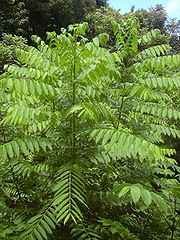
- CarapaCarapaCarapa is a genus in the mahogany family Meliaceae. The c. 25 species become medium-sized to large trees to 30 m tall, occurring in tropical South America and Africa; common names for include Andiroba and Crabwood.-Species:...
- Carapa guianensis
- Cedrela odorataCedrela odorataCedrela odorata . The genus Cedrela has undergone two major systematic revisions since 1960. The most recent revision reduced the number of species in the genus to seven . The common cedro, Cedrela odorata L., embraces 28 other named species, including C. mexicana M. J...
- GuareaGuareaGuarea is a genus of evergreen trees in the mahogany family Meliaceae, native to tropical Africa and Central and South America. They are large trees 20-45 m tall, with a trunk over 1 m trunk diameter, often buttressed at the base. The leaves are pinnate, with 4-6 pairs of leaflets, the terminal...
- Guarea guidonia
- Swietenia mahagoniSwieteniaSwietenia is a genus of trees in the chinaberry family, Meliaceae. It occurs natively in the Neotropics, from southern Florida, the Caribbean, Mexico and Central America south to Bolivia...
(West Indian Mahogany) - TrichiliaTrichiliaTrichilia is a flowering plant genus in the family Meliaceae. These plants are particularly diverse in sub-Saharan Africa and tropical South America....
- Trichilia hirta
- Trichilia triacanthaTrichilia triacanthaTrichilia triacantha is a species of plant in the Meliaceae family. It is endemic to Puerto Rico. It is threatened by habitat loss. It is a federally listed endangered species of the United States....
MoraceaeMoraceaeMoraceae — often called the mulberry family or fig family — are a family of flowering plants comprising about 40 genera and over 1000 species. Most are widespread in tropical and subtropical regions, less so in temperate climates...
- CecropiaCecropiaCecropia is a Neotropical genus presently consisting of sixty-one recognized species with a highly distinctive lineage of dioecious trees....
- Cecropia peltataCecropia peltataCecropia peltata is a plant in the Cecropia genus. Common names include pumpwood and trumpet tree. It is listed as one of the world's 100 worst invasive species....
- Cecropia schreberiana
- Cecropia peltata
- FicusFicusFicus is a genus of about 850 species of woody trees, shrubs, vines, epiphytes, and hemiepiphyte in the family Moraceae. Collectively known as fig trees or figs, they are native throughout the tropics with a few species extending into the semi-warm temperate zone. The Common Fig Ficus is a genus of...
- Ficus americanaFicus americanaFicus americana, commonly known as the West Indian laurel fig, or Jamaican cherry fig is a tree in the family Moraceae which is native to the Caribbean, Mexico in the north, through Central and South America south to southern Brazil. It is an introduced species in Florida, USA...
- Ficus aureaFicus aureaFicus aurea, commonly known as the Florida strangler fig , golden fig, or higuerón, is a tree in the family Moraceae that is native to the U.S. state of Florida, the northern and western Caribbean, southern Mexico and Central America south to Panama...
- Ficus citrifoliaFicus citrifoliaFicus citrifolia, also known as the Shortleaf Fig, Giant Bearded Fig or Wild Banyantree, is a species of banyan native to southern Florida, the Caribbean, Central America, and northern South America south to Paraguay...
- Ficus maximaFicus maximaFicus maxima is a fig tree which is native to Mexico, Central America, the Caribbean and South America south to Paraguay. Figs belong to the Moraceae family...
- Ficus americana
- Maclura tinctoria
MyrtaceaeMyrtaceaeThe Myrtaceae or Myrtle family are a family of dicotyledon plants, placed within the order Myrtales. Myrtle, clove, guava, feijoa, allspice, and eucalyptus belong here. All species are woody, with essential oils, and flower parts in multiples of four or five...
- EugeniaEugeniaEugenia is a genus of flowering plants in the myrtle family Myrtaceae. It has a worldwide, although highly uneven, distribution in tropical and subtropical regions. The bulk of the approximately 1,000 species occur in the New World tropics, especially in the northern Andes, the Caribbean, and the...
- Eugenia axillaris
- Eugenia biflora
- Eugenia cruegeri
- Eugenia foetidaEugenia foetidaEugenia foetida is a member of the family Myrtaceae, the myrtle family, and is colloquially referred to as "Spanish Stopper" or "Boxleaf Stopper."...
- Eugenia lingustrina
- Eugenia monticola
- Eugenia procera
- Eugenia rhombea
- Eugenia woodburyanaEugenia woodburyanaEugenia woodburyana is a species of plant in the Myrtaceae family. It is endemic to Puerto Rico. It is a federally listed endangered species of the United States. It is threatened by habitat loss....
- Eugenia xerophytica
- Myrciaria floribunda
- Psidium
- Psidium amplexicaule
- Psidium guajava (GuavaGuavaGuavas are plants in the myrtle family genus Psidium , which contains about 100 species of tropical shrubs and small trees. They are native to Mexico, Central America, and northern South America...
)
NyctaginaceaeNyctaginaceaeNyctaginaceae, the Four O'Clock Family, is a family of around 33 genera and 290 species of flowering plants, widely distributed in tropical and subtropical regions, with a few representatives in temperate regions...
- Guapira fragrans
- Neea buxifolia
- PisoniaPisoniaPisonia is a genus of flowering plants in the four o'clock flower family, Nyctaginaceae. It was named for Dutch physician and naturalist Willem Piso . Certain species in this genus are known as Catchbirdtrees because their sticky seeds reportedly trap small birds...
- Pisonia aculeata
- Pisonia albida
- Pisonia subcordata
PinaceaePinaceaePinaceae are trees or shrubs, including many of the well-known conifers of commercial importance such as cedars, firs, hemlocks, larches, pines and spruces. The family is included in the order Pinales, formerly known as Coniferales. Pinaceae are supported as monophyletic by its protein-type sieve...
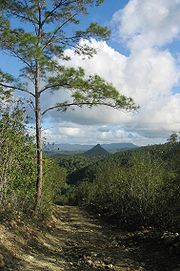
- Pinus
- Pinus caribaea
- Pinus cubensis
- Pinus occidentalis
- Pinus tropicalis
PodocarpaceaePodocarpaceaePodocarpaceae is a large family of mainly Southern Hemisphere conifers, comprising about 156 species of evergreen trees and shrubs. It contains 19 genera if Phyllocladus is included and if Manoao and Sundacarpus are recognized....
- PodocarpusPodocarpusPodocarpus is a genus of conifers, the most numerous and widely distributed of the podocarp family Podocarpaceae. The 105 species of Podocarpus are evergreen shrubs or trees from 1-25 m in height...
- Podocarpus angustifoliusPodocarpus angustifoliusPodocarpus angustifolius is a species of conifer in the Podocarpaceae family.It is found only in Cuba.-Source:* Conifer Specialist Group 2000. . Downloaded on 10 July 2007....
- Podocarpus aristulatusPodocarpus aristulatusPodocarpus aristulatus is a small to medium-sized evergreen tree in the conifer family Podocarpaceae. It is found on the Caribbean islands of Hispaniola and Cuba.-Description:...
- Podocarpus coriaceusPodocarpus coriaceusPodocarpus coriaceus is a species of conifer in the Podocarpaceae family.It is found in the Dominican Republic, Guadeloupe, Martinique, Montserrat, Puerto Rico, and Saint Kitts and Nevis.-References:...
- Podocarpus hispaniolensisPodocarpus hispaniolensisPodocarpus hispaniolensis is a species of conifer in the Podocarpaceae family.It is found only in the Dominican Republic.-Source:* Conifer Specialist Group 2000. . Downloaded on 10 July 2007....
- Podocarpus purdieanusPodocarpus purdieanusPodocarpus purdieanus is a species of conifer in the Podocarpaceae family.It is found only in Jamaica.-Source:* Conifer Specialist Group 2000. . Downloaded on 10 July 2007....
- Podocarpus trinitensisPodocarpus trinitensisPodocarpus trinitensis is a species of conifer in the Podocarpaceae family. It is endemic to Trinidad and Tobago, where it has only been recorded from the island of Trinidad...
- Podocarpus urbaniiPodocarpus urbaniiPodocarpus urbanii is a species of conifer in the Podocarpaceae family.It is found only in Jamaica.-Source:* Bellingham, P. 1998. . Downloaded on 10 July 2007....
- Podocarpus angustifolius
PolygonaceaePolygonaceaePolygonaceae is a family of flowering plants known informally as the "knotweed family" or "smartweed family"— "buckwheat family" in the United States. The name is based on the genus Polygonum and was first used by Antoine Laurent de Jussieu in 1789 in his book, Genera Plantarum. The name refers...
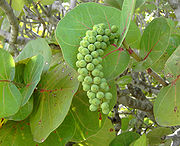
- CoccolobaCoccolobaCoccoloba is a genus of about 120–150 species of flowering plants in the family Polygonaceae. The genus is native to tropical and subtropical regions of the Americas, in South America, the Caribbean and Central America, with two species extending into Florida.The species are shrubs and trees,...
- Coccoloba diversifolia
- Coccoloba krugii
- Coccoloba microstachya
- Coccoloba swartzii
- Coccoloba uviferaCoccoloba uviferaCoccoloba uvifera is a species of flowering plant in the buckwheat family, Polygonaceae, that is native to coastal beaches throughout tropical America and the Caribbean, including southern Florida, the Bahamas, Barbados and Bermuda...
(Sea grape)
RhamnaceaeRhamnaceaeRhamnaceae, the Buckthorn family, is a large family of flowering plants, mostly trees, shrubs and some vines.The family contains 50-60 genera and approximately 870-900 species. The Rhamnaceae have a worldwide distribution, but are more common in the subtropical and tropical regions...
- ColubrinaColubrinaColubrina is a genus of about 30 species of flowering plants in the buckthorn family, Rhamnaceae, native to warm temperate to tropical regions of Africa, the Americas, southern Asia, northern Australia, and the Indian Ocean islands. Common names include nakedwood, snakewood, greenheart and hogplum...
- Colubrina arborescens
- Colubrina ellipticaColubrina ellipticaColubrina elliptica, Mabi or Soldierwood, is a species of flowering tree in the buckthorn family, Rhamnaceae, that is native to the Florida Keys, the Caribbean, Central America, Mexico, and Venezuela.-Uses:...
- ReynosiaReynosiaReynosia is a genus of plant in family Rhamnaceae.Species include:* Reynosia jamaicensis, M.C. Johnston...
- Reynosia guama
- Reynosia uncinata
- Krugiodendron ferreumKrugiodendron ferreumKrugiodendron ferreum, commonly known as the Black Ironwood or Leadwood, is a species of tree in the buckthorn family, Rhamnaceae. It is found in southern Florida, throughout the Caribbean and from southern Mexico to Honduras...
- Ziziphus reticulata
RhizophoraceaeRhizophoraceaeRhizophoraceae is a family constituted by tropical or subtropical flowering plants. Among the better known members are mangrove trees of the genus Rhizophora...
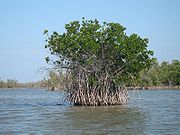
- Rhizophora mangleRhizophora mangleRhizophora mangle, known as the red mangrove, is distributed in estuarine ecosystems throughout the tropics. Its viviparous "seeds," in actuality called propagules, become fully mature plants before dropping off the parent tree...
RubiaceaeRubiaceaeThe Rubiaceae is a family of flowering plants, variously called the coffee family, madder family, or bedstraw family. The group contains many commonly known plants, including the economically important coffee , quinine , and gambier , and the horticulturally valuable madder , west indian jasmine ,...
- AntirheaAntirheaAntirhea is a genus of flowering plants in the Rubiaceae family. It is found on the Mascarenes, in Tropical and Subtropical Asia and in the South West Pacific.-Species:...
- Antirhea acutata
- Antirhea lucida
- Erithalis fruticosa
- Exostema caribaeum
- Genipa americanaGenipa americanaGenipa americana is a species of Genipa, native to northern South America , the Caribbean and southern Mexico, growing in rainforests. It is commonly called Genipapo or Huito; the alternate name Jagua may refer to other species of Genipa as well. To the Inca, it was known as hawa or wituq...
- GuettardaGuettardaGuettarda is a plant genus in the family Rubiaceae. Most of these plants are known by the common name Velvetseed. Estimates of the number of species range from about 50 to 162. Most of the species are neotropical. Twenty are found in New Caledonia and one reaches Australia...
- Guettarda elliptica
- Guettarda krugii
- Guettarda odorata
- RandiaRandiaRandia can refer to:*Rand's Warbler , a bird species*Randia , a genus of plants in the Rubiaceae...
- Randia aculeataRandia aculeataRandia aculeata, commonly known as white indigoberry or white indigo berry, is a species in the Rubiaceae. It is a shrub or small tree that grows from 2 to 6 m tall. R...
- Randia portoricensisRandia portoricensisRandia portoricensis, known commonly as the Puerto Rico Indigoberry, is a species of shrub in the family Rubiaceae. It is endemic to Puerto Rico, and is found in thickets and semi-dry forests....
- Randia aculeata
- Rondelita inermis
RutaceaeRutaceaeRutaceae, commonly known as the rue or citrus family, is a family of flowering plants, usually placed in the order Sapindales.Species of the family generally have flowers that divide into four or five parts, usually with strong scents...
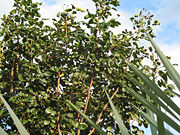
- AmyrisAmyrisAmyris is a genus of flowering plants in the citrus family, Rutaceae. The generic name is derived from the Greek word αμυρων , which means "intensely scented" and refers to the strong odor of the resin...
- Amyris balsamifera
- Amyris elemiferaAmyris elemiferaAmyris elemifera, commonly known as Sea Torchwood, is a coastal evergreen shrub or small tree. It is found in central and southern Florida in the United States, The Bahamas, the Caribbean, and the Central American countries of Guatemala, Belize, Honduras, and El Salvador. The resinous wood has been...
- ZanthoxylumZanthoxylumZanthoxylum is a genus of about 250 species of deciduous and evergreen trees and shrubs in the citrus or rue family, Rutaceae, native to warm temperate and subtropical areas worldwide. Common names include Prickly-ash and Hercules' Club.The fruit of several species are used to make the spice...
- Zanthoxylum flavumZanthoxylum flavumZanthoxylum flavum is a medium-sized tree in the citrus family, Rutaceae. Common names include Noyer,West Indian Satinwood, Yellow Sanders, Tembetaria, and Yellow Sandalwood...
- Zanthoxylum martinicense
- Zanthoxylum monophyllum
- Zanthoxylum spinifex
- Zanthoxylum thomasianumZanthoxylum thomasianumZanthoxylum thomasianum, also known as the St. Thomas Prickly-ash, is a species of plant in the Rutaceae family. It is found in Puerto Rico, the British Virgin Islands, and the United States Virgin Islands. Its natural habitats are tropical and subtropical dry broadleaf forests and shrublands. It...
- Zanthoxylum flavum
SapindaceaeSapindaceaeSapindaceae, also known as the soapberry family, is a family of flowering plants in the order Sapindales. There are about 140-150 genera with 1400-2000 species, including maple, horse chestnut and lychee....
- Cupania americana
- Melicoccus bijugatusMelicoccusMelicoccus is a genus of ten species of flowering plants in the family Sapindaceae, native to tropical regions of northern and western South America....
- Thouinia striata
SapotaceaeSapotaceaeSapotaceae is a family of flowering plants, belonging to order Ericales. The family includes approximately 800 species of evergreen trees and shrubs in approximately 65 genera . Distribution is pantropical....
- ChrysophyllumChrysophyllumChrysophyllum is a genus of about 70-80 species of tropical trees, growing rapidly to 10–20 m or more in height. The genus is native to tropical regions throughout the world, with the greatest number of species in northern South America. One species, C...
- Chrysophyllum argenteum
- Chrysophyllum cainitoChrysophyllum cainitoChrysophyllum cainito is a tropical tree of the family Sapotaceae, native to the lowlands of Central America and the West Indies. It grows rapidly and reaches 20 m in height....
- Chrysophyllum oliviforme
- Chrysophyllum pauciflorum
- ManilkaraManilkaraManilkara is a genus of trees in the family Sapotaceae. Collectively known as manilkara trees, they occur throughout the tropics. A close relative is the genus Pouteria....
- Manilkara bidentata
- Manilkara excisaManilkara excisaManilkara excisa is an endangered species of tall tree in the Sapodilla family. It is endemic to the extremely steep, forested limestone hills of Trelawny, Cockpit Country and St. James parishes in Jamaica, where, although it is highly prized for its wood, it is threatened by habitat loss....
- Manilkara gonavensisManilkara gonavensisManilkara gonavensis is a tree species in the Sapodilla family, found nowhere else but Haiti. It has only ever been collected one time for study, when the type specimen was taken. This was in the early 20th century, before 1929, which is the year it was described...
- Manilkara jaimiqui
- Manilkara mayarensisManilkara mayarensisManilkara mayarensis is a plant species in the family of Sapodillas, which grows wild only in Cuba's Oriente Province. Here its members range in scale from shrubs to small trees...
- Manilkara pleeanaManilkara pleeanaManilkara pleeana is a species of plant in the Sapotaceae family. It is endemic to Puerto Rico....
- Manilkara sideroxylon
- Manilkara valenzuelanaManilkara valenzuelanaManilkara valenzuelana is a species of tree or tall shrub in the Sapodilla family. It is found in coastal and subcoastal semi-deciduous forests in Cuba , the Dominican Republic, Haiti, and possibly Puerto Rico. Its habitat has been declining rapidly under pressure from charcoal makers, logging, and...
- MicropholisMicropholisMicropholis is flowering plant genus in the family Sapotaceae, containing 38 species. These trees occur mainly in tropical South America, and most locally known as "cafetos", literally meaning "coffee plants"...
- Micropholis chrysophylloides
- PouteriaPouteriaPouteria is a genus of flowering trees in the gutta-percha family, Sapotaceae. The genus is widespread throughout the tropical regions of the world. It includes the Canistel , the Mamey Sapote and the Lúcuma...
- Pouteria multiflora
- Pouteria sapotaMamey sapoteThe mamey sapote is a species of tree native to southern Mexico. Today, the tree is cultivated not only in Mexico, but also in Central America, the Caribbean, and South Florida for its fruit, which is commonly eaten in many Latin American countries...
–Mamey sapoteMamey sapoteThe mamey sapote is a species of tree native to southern Mexico. Today, the tree is cultivated not only in Mexico, but also in Central America, the Caribbean, and South Florida for its fruit, which is commonly eaten in many Latin American countries...
- PradosiaPradosiaPradosia is a genus of plant in family Sapotaceae.Species include:* Pradosia argentea, T.D.Penn.* Pradosia atroviolacea, Ducke* Pradosia cuatrecasasii, T.D.Penn.* Pradosia decipiens, Ducke...
- SideroxylonSideroxylonSideroxylon is a genus of flowering plants in the family Sapotaceae. There are about 70 species, collectively known as bully trees. The generic name is derived from the Greek words σιδηρος , meaning "iron", and ξύλον , meaning "wood."-Distribution:The genus is distributed mainly in the neotropics,...
- Sideroxylon obovatum
- Sideroxylon salicifolium
TheophrastaceaeTheophrastaceaeTheophrastaceae is a small family of flowering plants. As currently circumscribed, the family consists of seven genera and 95 species of trees or shrubs, native to tropical regions of the Americas....
- JacquiniaJacquiniaJacquinia is a genus of evergreen shrubs and trees in the family Theophrastaceae, native to Central America and the Caribbean.The genus was established by Linnaeus in 1760 and named by him in honor of Jacquin.There are about 86 species. ....
- Jacquinia armillaris
- Jacquinia berteroi
- Jacquinia umbellata
ZamiaceaeZamiaceaeThe Zamiaceae are a family of cycads that are superficially palm or fern-like. They are divided into two subfamilies with eight genera and about 150 species in the tropical and warm temperate regions of Africa, Australia and North and South America....
- ZamiaZamiaZamia is a genus of cycad of the family Zamiaceae, containing around 50 species, native to North, Central and South America. Species occur as far north as Georgia in the United States to as far south as Bolivia Zamia is a genus of cycad of the family Zamiaceae, containing around 50 species, native...
- Zamia amblyphyllidiaZamia amblyphyllidiaZamia amblyphyllidia is a species of plant in the Zamiaceae family. It is found in Cuba, Jamaica, and Puerto Rico. It is threatened by habitat loss.-Source:* Donaldson, J.S. 2003. . Downloaded on 24 August 2007.*Beaumont, Gary. PACSOA....
- Zamia portoricensisZamia portoricensisZamia portoricensis is a species of plant in the Zamiaceae family. It is endemic to Puerto Rico.-Source:* Donaldson, J.S. 2003. . Downloaded on 24 August 2007....
- Zamia pumilaZamia pumilaZamia pumila, or Coontie, is a small, tough, woody cycad of the West Indies and Cuba. Zamia pumila was the first species described for the genus and hence is the type species for the genus Zamia and the family Zamiaceae....
–Coontie
- Zamia amblyphyllidia
ZygophyllaceaeZygophyllaceaeThe Zygophyllaceae is a family of flowering plants that contains the bean-caper and caltrop. It includes around 285 species in 22 genera.In the APG III system of classification, the families Zygophyllaceae and Krameriaceae compose the order Zygophyllales...
- GuaiacumGuaiacumGuaiacum, sometimes spelled Guajacum, is a genus of flowering plants in the caltrop family Zygophyllaceae. It contains five species of slow-growing shrubs and trees, reaching a height of approximately but are usually less than half of that...
- Guaiacum officinaleGuaiacum officinaleGuaiacum officinale, commonly known as Roughbark Lignum-vitae, is a species of tree in the caltrop family, Zygophyllaceae, that is native to the Caribbean and the northern coast of South America.-Description:...
–true Lignum vitaeLignum vitaeLignum vitae is a trade wood, also called guayacan or guaiacum, and in parts of Europe known as pockenholz, from trees of the genus Guaiacum. This wood was once very important for applications requiring a material with its extraordinary combination of strength, toughness and density... - Guaiacum sanctumGuaiacum sanctumGuaiacum sanctum, commonly known as Holywood or Holywood Lignum-vitae, is a species of flowering plant in the creosote bush family, Zygophyllaceae. It ranges from southern Florida in the United States and the Bahamas south to Central America and the Greater Antilles...
- Guaiacum officinale
AnacardiaceaeAnacardiaceaeAnacardiaceae are a family of flowering plants bearing fruits that are drupes and in some cases producing urushiol, an irritant. Anacardiaceae include numerous genera with several of economic importance. Notable plants in this family include cashew , mango, poison ivy, sumac, smoke tree, and marula...
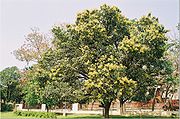
- MangoMangoThe mango is a fleshy stone fruit belonging to the genus Mangifera, consisting of numerous tropical fruiting trees in the flowering plant family Anacardiaceae. The mango is native to India from where it spread all over the world. It is also the most cultivated fruit of the tropical world. While...
(Mangifera indica)
FabaceaeFabaceaeThe Fabaceae or Leguminosae, commonly known as the legume, pea, or bean family, is a large and economically important family of flowering plants. The group is the third largest land plant family, behind only the Orchidaceae and Asteraceae, with 730 genera and over 19,400 species...
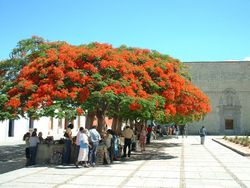
- Samaan tree (Albizia saman)
- FlamboyantRoyal PoincianaDelonix regia is a species of flowering plant from the Fabaceae family, Caesalpinioideae subfamilia, noted for its fern-like leaves and flamboyant display of flowers. In many tropical parts of countries around the world it is grown as an ornamental tree and in English it is given the name Royal...
(Delonix regia) - TamarindTamarindTamarind is a tree in the family Fabaceae. The genus Tamarindus is monotypic .-Origin:...
(Tamarindus indica)
VerbenaceaeVerbenaceaeVerbenaceae, commonly known as the verbena family or vervain family, is a family of mainly tropical flowering plants. It contains trees, shrubs and herbs notable for heads, spikes, or clusters of small flowers, many of which have an aromatic smell.Recent phylogenetic studies have shown that...
_i_img_8133.jpg)
- TeakTeakTeak is the common name for the tropical hardwood tree species Tectona grandis and its wood products. Tectona grandis is native to south and southeast Asia, mainly India, Indonesia, Malaysia, and Burma, but is naturalized and cultivated in many countries, including those in Africa and the...
(Tectona grandis)

